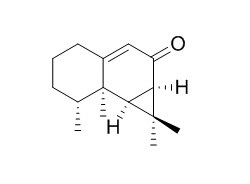Aristolone
Aristolone is a natural product from the leaf oil of Alpinia polyantha.
Inquire / Order:
manager@chemfaces.com
Technical Inquiries:
service@chemfaces.com
Tel:
+86-27-84237783
Fax:
+86-27-84254680
Address:
1 Building, No. 83, CheCheng Rd., Wuhan Economic and Technological Development Zone, Wuhan, Hubei 430056, PRC
Providing storage is as stated on the product vial and the vial is kept tightly sealed, the product can be stored for up to
24 months(2-8C).
Wherever possible, you should prepare and use solutions on the same day. However, if you need to make up stock solutions in advance, we recommend that you store the solution as aliquots in tightly sealed vials at -20C. Generally, these will be useable for up to two weeks. Before use, and prior to opening the vial we recommend that you allow your product to equilibrate to room temperature for at least 1 hour.
Need more advice on solubility, usage and handling? Please email to: service@chemfaces.com
The packaging of the product may have turned upside down during transportation, resulting in the natural compounds adhering to the neck or cap of the vial. take the vial out of its packaging and gently shake to let the compounds fall to the bottom of the vial. for liquid products, centrifuge at 200-500 RPM to gather the liquid at the bottom of the vial. try to avoid loss or contamination during handling.
Process Biochemistry2019, 85:106-115
Antioxidants (Basel).2022, 11(8):1471.
Journal of Analytical Chemistry2017, 854-861
Phytomedicine.2023, 116:154841.
J Herbmed Pharmacol.2018, 7(4):280-286
Int J Mol Sci.2024, 25(6):3390.
National Academy Science Letters2023, s40009.
Biomed Pharmacother.2022, 145:112474.
Redox Biology2024, 103197.
Front Nutr.2023, 10:1181135.
Related and Featured Products
Nat Prod Commun. 2013 Mar;8(3):287-8.
New bioactive secondary metabolites from Bornean red alga, Laurencia similis (Ceramiales).[Pubmed:
23678792]
METHODS AND RESULTS:
A Bomean red algal population of Laurencia similis Nam et Saito was analyzed for its secondary metabolite composition. Seven compounds were identified: ent-1(10)-aristolen-9beta-ol (1), ( )-Aristolone (2), axinysone B (3), 9-aristolen-1alpha-ol (4), 2,3,5,6-tetrabromoindole (5), 1-methyl-2,3,5,6-tetrabromoindole (6), and 1-methyl-2,3,5-tribromoindole (7). Compound 1 was identified as a new optical isomer of 1(10)-aristolen-9beta-ol.
CONCLUSIONS:
Compounds 1, 4 and 5 exhibited good antibacterial activity against antibiotic resistant clinical bacteria and cytotoxic effects against selected cancer cell lines.
Nat Prod Commun. 2015 Feb;10(2):367-8.
Chemical constituents of essential oils from the leaves, stems, roots and fruits of Alpinia polyantha.[Pubmed:
25920286]
The essential oils obtained from the leaves, stems, roots and fruits of Alpinia polyantha D. Fang (Zingiberaceae) have been studied.
METHODS AND RESULTS:
The leaf oil was comprised mainly of camphor (16.1%), α-pinene (15.2%) and β-agarofuran (12.9%), while the major constituents of the stem oil were α-pinene (12.4%), β-cubebene (10.6%), β-agarofuran (10.3%) and globulol (8.8%). However, β-cubebene (12.6%), fenchyl acetate (10.8%), β-maaliene (9.0%), Aristolone (8.8%) and α-pinene (8.2%) were the compounds occurring in higher amounts in the root oil. The quantitatively significant compounds of the fruit oil were δ-cadinene (10.9%), β-caryophyllene (9.1%), β-pinene (8.7%) and α-muurolene (7.7%).



